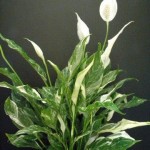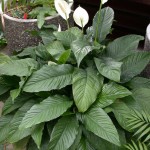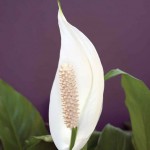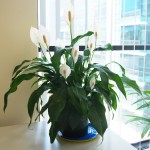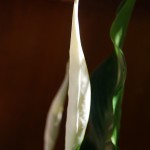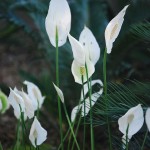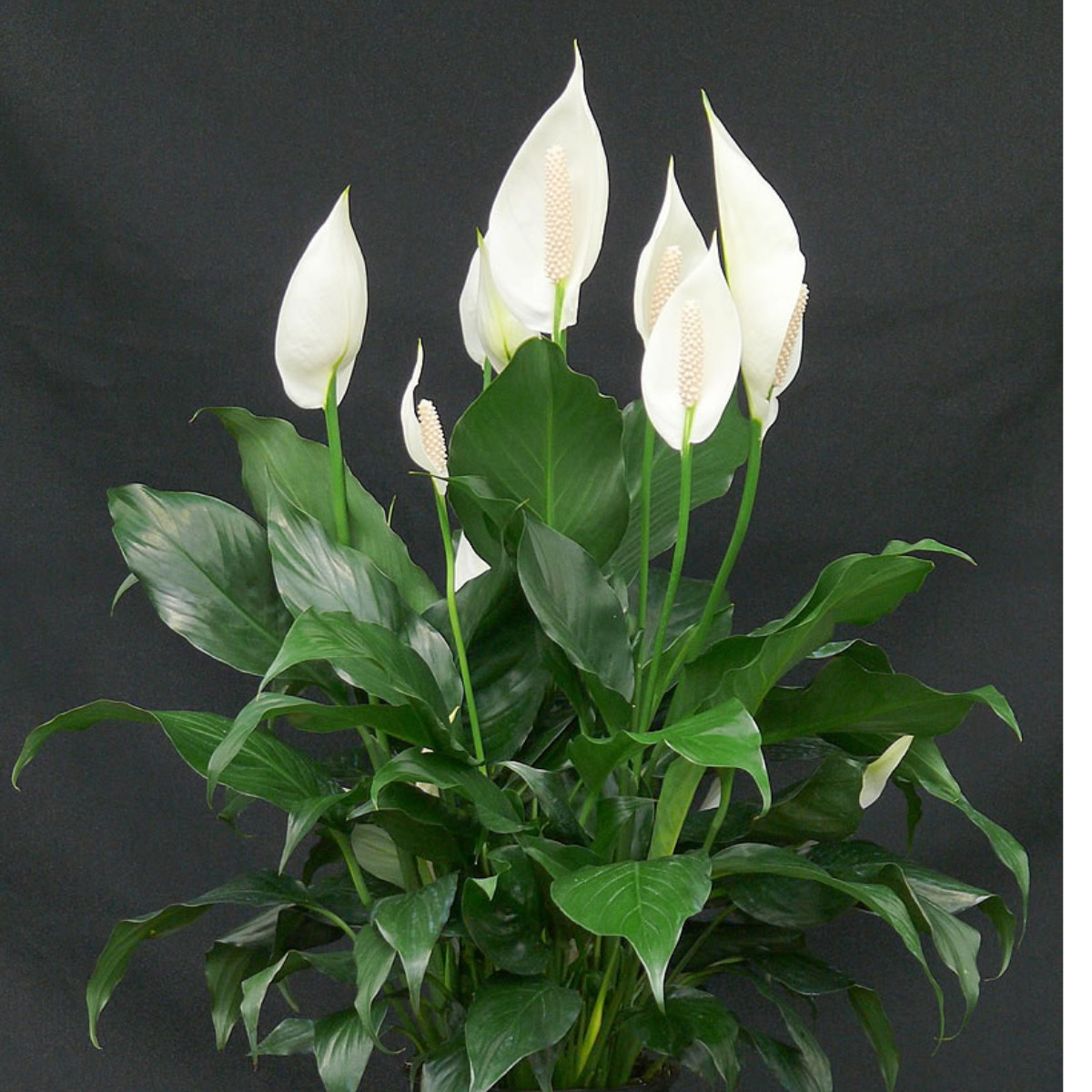Family: Araceae
Distribution and habitat: Spathiphyllum wallisii is one of approximately 40 species in a genus of tropical evergreens. It is growing wild in tropical regions of Central America, usually found in wet habitats. Its natural habitat are the rainforests, in the shade of larger trees, where Spathiphyllum wallisii receive very little direct sunlight and have adapted to live in low-light conditions. Their native environment stays between 21 and 32C (70-90F) year round and receives as much as 10000mm (400 inch) of rain annually.
Decsription: Spathiphyllum wallisii are almost stemless, evergreen, perennial plants with short underground rhizomes that send up clusters of lance-shaped or elliptic, dark green leaves on sheathed leaf-stalk. These plants are grown for their glossy leaves, brilliant spathes and scented flowers. Its leaves, on 15cm (6 inch) long stalks, are 15cm (6 inch) long and 8cm (3 inch) wide and strongly veined, arching away from the base of the plant, making this an attractive foliage plant even when not in bloom.
Flower heads arising from centres of leaf clusters are produced mainly in spring and often again in late summer on 20-25cm (8-10 inch) long stalks that tower above the foliage. Each flower head consist of a large white spathe surrounding an erect, 5-7cm (2-2.5 inch) long spadix cream coloured. The spathe is pointed-oval, 7-10cm (2.5-4 inch) long and 5-7cm(2-2.5 inch) wide. The usually fragrant flower head keeps its original colour for only about a week. The spathe gradually change from white to light green and remains attractive for a further five to six weeks. It then begins to become unsightly and is best removed.
Spathiphyllum wallisii is the only true species commonly grown indoors, rarely grows more than 30cm (12 inch) high.
Houseplant care: The plants can naturally withstand abuse since they must live through the dry season in their native habitat which at times requires them to survive when little water is available but they do have limitations and cannot withstand perpetual abuse and neglect in a home.
Growth rates of Spathiphyllum wallisii are slow to medium.
When flowers start to fade, cut off the flower stalks as close to the base as possible.
Light: Grow Spathiphyllum wallisii is medium light. Direct sunlight will burn the leaves. This plant will tolerate low light, but may bloom poorly.
Temperature: Normal room temperatures are suitable for these plants (18-24C (64-75F)). Minimum tolerable temperature is 10C (50F).
In temperatures of 18C (64F) and above there is unlikely to be a noticeable rest period. Growth may slow down during the winter, however.
Humidity: Spathiphyllum wallisii are particularly sensitive to dry air and should be kept on trays of moist pebbles throughout the year. The leaves should also be mist-sprayed frequently. It needs a relative humidity of 40% or higher.
Watering: Water moderately, enough at each watering to make the potting mixture moist throughout but allowing the top centimetre (0.4 inch) or so of the potting mixture to dry out before watering again. If the temperatures falls below 15C (59F) for more than a day or two, reduce the quantity of water, making the potting mixture barely moist.
It is important never to let the potting mixture dry out completely.
Feeding: Apply standard liquid fertiliser every two weeks from early spring to late autumn (when Spathiphyllum wallisii grow most actively). Continue feeding throughout the year for plants that are actively growing in peat-based mixture.
Potting and repotting: Use either a peat-based potting mixture or an equal-parts combination of soil-based mixture, leaf mould and coarse sand or perlite. Move plants into pots one size larger every spring until the maximum convenient pot size (probably 15-20cm (6-8 inch)) has been reached. Thereafter, it will be enough to top dress plants annually with fresh potting mixture.
This plant likes to be slightly pot-bound. Divide it every 5 years or when necessary.
Gardening: Spathiphyllum wallisii are intolerant of full sun or elevated salinity levels. Avoid drying winds, exposure to salty water and direct sun. Plant it into the ground only within its hardiness zones, otherwise use potted plants or transplant them into the pots in autumn when the temperatures drop below 10C (50F).
Location: Use this plant in a partially or fully shaded location in the landscape, protected from high wind.
This plant can be used as a ground cover in completely shady areas of the landscape.
Soil: Outdoors Spathiphyllum wallisii plants should be grown in fertile acidic to neutral loamy organic soils with a steady but well drained moisture supply.
Irrigation: Water thoroughly, but do not allow the soil to get soggy.
In dry areas, provide copious amounts of water or place the plant near a pond to keep the humidity high. A low spot that is naturally damp but still has adequate drainage is an ideal location for Spathiphyllum wallisii.
Fertilise: Fertilise this plant regularly during the growing season to maintain a dark green foliage color. Use a liquid fertiliser once a month.
Propagation: Propagate the Spathiphyllum wallisii in spring by dividing overcrowded clusters of leaves. Pull rhizomes apart gently, making sure that each piece has at least two or three leaves attached. Plant individual pieces in 8cm (3 inch) pots of either of the recommended potting mixture, burying each piece at the same depth as the entire rhizome was planted.
Do not apply any fertiliser to the newly potted rhizome sections for three months. Otherwise, treat them as mature Spathiphyllum wallisii.
Problems:
Red spider mites will attack Spathiphyllum wallisii if the humidity is low. Mist-spray the foliage at least once a week, concentrating on leaf-undersides, which is where these mites collect.
Plants will deteriorate rapidly if the minimum temperature is not maintained.
Brown leaf tips are likely caused by overwatering. It could also be caused by direct sun.
Treatment: Move the plant to a shadier spot and be careful not to overwater.
A plant is likely to be overfertilised if the leaves end up with brown spots on them.
Treatment: Stop fertilising the plant. Flush the potting mixture with plenty of water to wash salt deposited on the roots taking care to drain the excess water from the drip tray.
If the leaves become shriveled and dry, the humidity is too low.
Treatment: Increase humidity by misting the plant or placing it on a tray of wet pebbles.
Spathiphyllum wallisii plants that fail to bloom usually are not getting enough sunlight.
Treatment: Move the plant to a brighter location, but keep it out of direct sun which can scorch leaves. Also, when old plant which has not been divided in several years and refuse to bloom, divide it in spring. This is one of the few plants that blooms better after dividing it.
Recommended varieties:
Spathiphyllum wallisii 'Domino' is a medium growing Spathiphyllum wallisii with beautiful variegate foliage. Spathiphyllum Domino has contrasting bright white and dark green leaves. It has a bushy habit of growth.
Spathiphyllum wallisii 'Mauna Loa' is an hybrid that can grow 60cm (24 inch) high with larger spathes and oblong lanceolate leaves. Flowers appear at almost any time throughout the year and last up to several months on plant, changing their colour from green to white to green.
Toxicity: Spathiphyllum wallisii is reported to be toxic to humans, cats and dogs as most tissues contain calcium oxalates; the sap of some taxa is also a skin irritant. Keep it away from children and pets who may play with or chew on it and wash hands thoroughly after handling it.
Uses and display: One of most reliable interior-scape plants, Spathiphyllum wallisii are outstanding as houseplants, conservatory or interior-scape plants, but are also a common component of tropical outdoor landscapes where they often serve as groundcovers, shade borders, or shade accents. Spathiphyllum wallisii make excellent container plants for shaded patios or can be used as a summer accent in shaded annual beds. Potted plants are suitable tabletops, plant stands and as floor specimens or dish garden.
This is one of the best plants for improving air quality indoors. Spathiphyllum species are known for removing benzene, a common household chemical and known carcinogen. It is also said to remove mold spores in the air, making it great for bathrooms, kitchens and laundry rooms; purifying the air of trichloroethylene, a chemical found in cleaners and solvents; and removing alcohols, acetone, and formaldehyde.
SUMMARY:
CHARACTERISTICS:
Foliage green
Features flowers, fragrance
Shape upright
Height: 22-30cm (9-12 inch)
PROPER CARE:
Watering in rest period sparingly
Watering in active growth period plentifully
Light medium
Temperature in rest period min 13oC max 16oC (55-61oF)
Temperature in active growth period min 16oC max 24oC (61-75oF)
Humidity high
Hardiness zone: 10b-11
